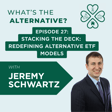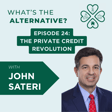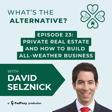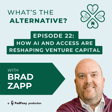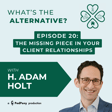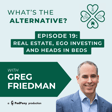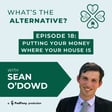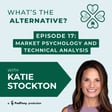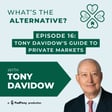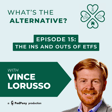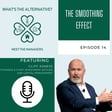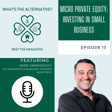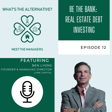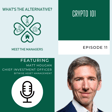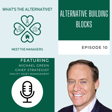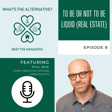Become a Creator today!Start creating today - Share your story with the world!
Start for free
00:00:00
00:00:01

What’s the Alternative? | Episode 21 | Finding Yield in a Volatile Market with Michael Sedacca
What do interest rate hikes really mean for your bond portfolio?
In this episode, Shana is joined by Michael Sedacca, Partner and Portfolio Manager at Rareview Capital, to break down how Federal Reserve policy cycles impact fixed income investing. From one of the most aggressive rate-hiking cycles in history to tactical opportunities in closed-end funds, Michael offers clear insights into what today’s interest rate environment means for investors.
We cover:
- How the Fed’s 5.5% rate hike cycle has shaped the bond market
- Why early homeowners with sub-4% mortgage rates are in a uniquely lucky position
- How closed-end funds can offer value through shifting premiums and discounts
- The surprising opportunities in commercial real estate and AAA-rated securities yielding 8–9%
Tune in to gain a clearer view of the bond market, interest rates, and smart strategies for what's ahead.
Connect with us!
Transcript
Federal Reserve's Impact on Fixed Income
00:00:00
Speaker
You have to be cognizant of what's the direction of the Federal Reserve cycle. Where are we in the different regimes of that Federal Reserve cycle? Are they raising an interest rate? Are they cutting an interest rate?
00:00:11
Speaker
Are they preparing to raise an interest rate? Because capturing that part of the the Federal Reserve cycle, is um that makes a big difference on fixed income returns relative to an index or just on an absolute basis.
00:00:26
Speaker
Pretty simple, when the Fed's raising interest rates, ah it's all you're gonna not make money, you're gonna lose money, you're gonna make less than your coupon. When the Fed's cutting interest rates, you're gonna make more money because your bond price is gonna go up.
00:00:36
Speaker
and their ga
00:00:41
Speaker
Welcome to Banruin Capital Management's What's the Alternative podcast. Join host Shana Orzek Sissel, the queen of alternatives and founder, CEO of Banruin Capital Management, as she interviews leaders in the alternative investment space.
00:00:59
Speaker
Learn more about their firms, their passions, and about the many different ways investors can use alternative investments to add value in their investment portfolios.
00:01:11
Speaker
Hello, everyone. this is Shayna Sissel, founder and CEO of Bondmean Capital Management, and you are tuning in to a new episode of What's the Alternative?
00:01:23
Speaker
This episode features Michael Sadaka. He is a partner and portfolio manager with Rareview Capital. one of our Liquid Alt manager partners on Boundaryon platform. Rareview is a firm you might not have heard of, but has really interesting product. And we're going to dive deep into some of the really unique ETFs that Rareview has brought to market.
00:01:45
Speaker
ah So with that, welcome, Michael. Thank you for joining us. Thank you, Shana. Thank you for having us having me. oh Why don't tell us a little bit about your background and how you kind of ended up at Rareview Capital?
00:01:58
Speaker
Sure, always had a affinity to the the the fixed income markets and managing money. And ah about 10 years ago this month, I started working with my partner, Neil Azuz, and we wanted to build products that were differentiated that would not be more passive off the shelf products that you might get from a mega ETF provider or or fund provider.
00:02:26
Speaker
and that is what started our journey to create uh one of the alternative products that we'll speak about today which is the dynamic fixed income uh strategy um it is a high income so if you think 10 years ago interest rates were at zero income was very hard to come by especially for savers or retirees we wanted to create a product that was differentiated that could uh give them that confident, repeated income on a month-to-month basis to fund their retirement or their lifestyles.
00:02:59
Speaker
Interesting.
Complexities in Fixed Income Strategies
00:03:00
Speaker
And you know it's funny because when I started working in the liquid alt space and I started evaluating ETFs, really, mutual funds too, but mostly ETFs that the industry has moved more and more to that structure, there isn't a ton of non-traditional kind of alternative products in the ah fixed income space.
00:03:19
Speaker
that have a yield component um that is really reliable and and and ah stable. And I think one the answer interesting things about your product is it actually is fairly reliable and stable in that respect, um which stands out to me. So, you know, fixed income markets, we don't talk about a lot on this show. So it's really good to have you here because our audience doesn't get to hear a ton from fixed income side.
00:03:45
Speaker
But I'd love to hear a little bit more about, you know, some of the complexities in fixed income. We keep seeing on the news the discussions about the yield curve and interest rates and how ah despite Fed policy and Fed rate cuts, you're not seeing that necessarily reflected in fixed income markets and in the yield curve. Can you talk a little bit about some of the fixed income dynamics that are going on today?
00:04:09
Speaker
Sure, certainly. So going back five years ago almost, ah the federal There was a a pandemic, there was a significant amount of stimulus, whether it was from the the monetary angle from the Federal Reserve or the fiscal angle primarily, which had not happened for well over a decade at that point.
00:04:29
Speaker
A significant amount of money was created. And lo and behold, there was significant amount of inflation. And the Federal Reserve embarked on the most aggressive ah and most significant interest rate hiking cycle to date.
00:04:42
Speaker
That caused a large amount of damage in the fixed income markets. ah At the time, interest rates were zero or close to zero across the entire yield curve, which made the price sensitivity on a generic fixed income portfolio never been higher, meaning 100 basis point increase in yields would have a ah outsized negative impact on your ah portfolio.
00:05:09
Speaker
And and As a result, there was ah an even larger movement towards alternative products or cash or T-bills because ah you couldn't receive that income without taking outrageous price risk to achieve it and fixed income.
00:05:24
Speaker
um Now, fast forward, the the Federal Reserve is raised interest rates by 5.5% at that point. Inflation, now having gone up, came back down at the fastest rate of all time.
00:05:37
Speaker
ah And the Federal Reserve became prepared to cut interest rates. That started about six months ago. And they rate they cut interest rates by 100 basis points.
00:05:48
Speaker
So even though they raised them by 5.25%, they only cut it by 100 basis points in the context of normally there's 3% to 4% of interest rate hikes. And then sometimes more in terms of interest rate cuts because it would come from a higher level.
00:06:02
Speaker
And that's what we're going to determine over the next one to two years is where is the neutral policy rate? um Has it shifted higher with fiscal stimulus being at a much higher level than what has been in the past?
00:06:15
Speaker
um And is there going to be any impact from the incoming ah The incoming administration, whether it's in Congress, which the Republican Party holds both houses and the executive branch, that will be what it takes moving forward to determine fixed income.
Monitoring Inflation and Its Effects
00:06:35
Speaker
But more importantly, how that impacts inflation. Inflation has the highest beta to Federal Reserve policy moving forward. um so that's that that's that's the one thing we're we're laser focused on is uh what is the outlook for inflation real estate prices have come down rental prices have come down that's the overall picture for the federal reserve and if it makes sense shana i could go into more in terms of fixed income asset classes if that will be oh absolutely that our like i said our audience never gets to hear a lot about fixed income we don't have a lot of fixed income guys come on but it's so timely because there's a lot of discussion about rates and and
00:07:12
Speaker
And that directly impacts yield curve and bond prices and bond yields. And, you know, we talk about inverted yield curves. And I think a lot of people don't understand that in order to not be inverted, even in cut environments, you still got to have the long end go up.
00:07:29
Speaker
Yeah. And so there there's some technical dynamics there that I think our audience would really appreciate hearing more of. And like I said, we never have folks with your ah type of expertise on the show. So go for it. This is exactly what our audience wants to hear.
00:07:43
Speaker
Well, great. Thank you. So ah first I'll just start with fixed income sectors with the strategy you referenced before. It's a dynamic fixed income strategy. So it's a multi-sector bond.
00:07:55
Speaker
What that means is anything besides treasuries is what we can be invested into to achieve a high yield or a high total return. And it's not just the traditional investment grade corporate bonds or high yield corporate bonds.
00:08:09
Speaker
um There's a significant difference asset class out there in emerging markets, whether it's hard currency or local currency, investment grade or high yield. Securitized debt, the non-agency space is ah much higher in terms of of spread or yield that you can achieve versus just buying general ah investment grade corporate bonds. um The spread pickup is well over 100 basis points, if not more.
00:08:35
Speaker
And then thinking you know more about there's a return to office right now. I'm assuming that all of your listeners have seen that no one's ever going to go to an office ever again.
00:08:45
Speaker
Office buildings are worth zero. They're going to crumble to the ground and you're going to get zero on your investments. The great thing about fixed income is it's highly quantitative in nature. If you can price something or you can see that something is priced at zero and if the office building crumbles to the ground and and there's nothing left about of the value of that and something is priced at zero and you buy it, you lose nothing. That's the best part of it.
00:09:10
Speaker
And if somebody ever goes back to an office ever again and those office values actually go up, you can make a significant return from there and you're being paid. for a investment grade rated piece of paper, you're being paid three, four or five percent more than treasuries on that. that That kind of risk and sit and the asymmetry is what we look for in our fixed income strategies because It's not just buy and hold.
00:09:36
Speaker
I'm going to buy five year bond or a seven year bond and put it away and forget about it for the next 10 years. There is times to be tactical. And that's what we focus on in the um liquid alternative space and being able to be nimble to to make those changes, not being benchmark constrained to the aggregate bond index.
00:09:55
Speaker
That's what we shoot for. And actually sorry. I was going to say that makes a lot of sense. And bond guys hate me for saying this. So I apologize. But when I was in grad school working towards my MBA, one of the things I used to say is I had to take an equity valuation class. I'd take fixed income valuation class.
00:10:11
Speaker
I always like the fixed income valuation class better. And all the bond guys would be like, why is that? It's more technical. There's all sorts of components to it. But the one thing the bond markets have that the equity markets don't have is like a terminal value, because at the end of the day, the bond has an end date yeah in most cases. And you know what PAR is and the bond, everything that happens between when it's issued and it's, you know, um the date it matures is kind of gets you back to that spot so like the mathematics is less um ah less opaque um to me at least because over and and and i think that's the interesting part of a lot of these strategies is there's a lot of technical factors but at the end of the day when you think about time value of cash flows and all that like foundational stuff that we talk about when we talk about evaluating any investment
00:11:04
Speaker
and In an equity, you're taking a stab at what the value of that equity is because there's no clear maturity date and there's no clear terminal value.
00:11:15
Speaker
But in fixed income, you have that. So the arbitrage opportunities are much more clear,
Equity vs Fixed Income Valuation
00:11:21
Speaker
and at least in my opinion. And what else what are your thoughts on that? Well, it's funny you mentioned the equity side is that a long time ago, one of my mentors told me something that I will never forget.
00:11:33
Speaker
said when you're trading in a stock uh you're you're buying ah a stock you're buying a company and When you can believe that, when you can understand that about why an equity can be valued as something and, hey, there's the fundamental of this or that, doesn't really matter.
00:11:48
Speaker
You're buying a stock, you're buying a symbol. You don't necessarily care as much about what the underlying fundamentals are. And certainly with fixed income, because it's a less volatile asset, a particular interest rates at a little bit higher level, it's less volatile asset.
00:12:03
Speaker
um you have to be cognizant of what's the direction of the Federal Reserve cycle. Where are we in the different regimes of that Federal Reserve cycle? Are they raising an interest rate?
00:12:14
Speaker
Are they cutting an interest rate? Are they preparing to raise an interest rate? Because capturing that part of the the Federal Reserve cycle, is um that makes a big difference on fixed income returns relative to an index or just on an absolute basis.
00:12:30
Speaker
Pretty simple, when the Fed's raising interest rates, ah it's all you're gonna not make money, you're gonna lose money, you're gonna make less than your coupon. When the Fed's cutting interest rates, you're gonna make more money because your bond price is gonna go up.
00:12:41
Speaker
just by I hate to say it sounds that simple, but it really is. the The introductory part of um a a fixed income cycle is is capturing that. And is the yield curve going to be flattening or steepening?
00:12:54
Speaker
um And just in terms of the the yield curve steepening, that really reflects the Federal Reserve is cutting. They're going to create future inflation risk. Okay, it's a steeper yield curve.
00:13:04
Speaker
The Federal Reserve is hiking. They're taking out inflation risk from the market. The yield curve flattens or inverts. When it stays inverted for a long time, um as that would be a negative pressure on financing.
00:13:19
Speaker
And financing is a big part or the biggest part. If a company cannot roll over its debt, it will go bankrupt. We live in ah in a world where debt is never repaid, it's just rolled over.
00:13:31
Speaker
So if companies can't roll over their debt, they will go bankrupt or they will have stress and they're you know they'll perform poorly, whether it's their equity or their fixed income. Yeah, it's interesting. you know Anyone who's ever taken a Series 7, Series 6, CFA, or any type of fixed income class in graduate school understands the seesaw.
00:13:52
Speaker
um That's like the basics of all things fixed income you have. Value of the underlying bond par on one side and you yield on the other side. And then they kind of move like this. The the yields go down.
00:14:04
Speaker
yeah ah that and the The price of the bond goes up and vice versa. um But there's more to that, like duration and things of that nature. And that's the Fed policy stuff you were just talking about.
00:14:16
Speaker
I'm curious, can you talk a little bit about the environment we're in today? Because ah the fixed income markets have behaved unusually, at least to an outsider who's not as... tune in to the dynamics of fixed income.
00:14:30
Speaker
And a lot of people are confused as to why the yield curve is not necessarily demonstrating or reflecting what you would expect, given that the Fed has cut rates.
00:14:41
Speaker
And what do you think is driving that? And what do you you think people should be aware of as they kind of look at that to make sense of that type of behavior and and and the yield curve? Absolutely. And that's one that we've heard a bunch and, uh,
00:14:55
Speaker
Really, it it stems back to um there's ah a neutral rate of policy for the Federal Reserve or the Fed funds rate. And that is what level of the Fed funds rate is restrictive or or easy, discrelative to the economy, i mean or really the financial economy, frankly.
00:15:12
Speaker
We estimate that somewhere in the low to mid 2% range, and it was lower last cycle. So when the Fed raised interest rates from zero 5.5%, they overshot neutral by at least 3%. they oversshone neutral by at least three percent um Historically, they're only overshooting it by about 75 basis points.
00:15:29
Speaker
So that's four times more than what the Fed would normally overshoot. Cause they always over tighten, you know, things are doing well at the time and they, and they do too much and something bad happens in the financial system. So they have to revert or the economy, whichever one matters at the time.
00:15:45
Speaker
Uh, so this time being. 300 basis points above neutral, the fixed income market priced in that return back to neutral policy, because that's what the Fed always do. They raise too much, they return back to neutral, and we see if they have to cut below neutral because things are going poorly.
00:16:02
Speaker
So heading into the interest rate cutting cycle ah last September, um the market was pre-pricing 275 basis points of interest rate cuts.
00:16:13
Speaker
So the yield curve, if you think about the three-month treasury versus the 10-year treasury, was extremely inverted. It has if is normally around zero at the start of an interest rate cutting cycle.
00:16:24
Speaker
It was at a negative 170. there was... so there was the the The starting point was much more than it's ever been. And it's kind of like it was priced for perfection, that there had to be this linear plunge to below 2% inflation because it was going from top left to bottom right for the past three years.
00:16:44
Speaker
I'm sorry, two like two and a half years on inflation. um and It has slowed down in the and the fourth quarter of last year. So the market priced in less cuts as a result. You know, and you can add in something for the Republican administration having inflationary offens effects from more fiscal stimulus.
Challenges in Predicting Rate Cuts
00:17:01
Speaker
That's really what's taking place right now is ah there was a one way train of of disinflation. from mid 2022 until six months ago or or or four months ago.
00:17:13
Speaker
And now we're just trying to determine is it is inflation going to stay, meaning core PCE e at 3% or the high 2% or is it going to get down to 2%? And there was a few months where that if it was going to down to 2% was called into question.
00:17:27
Speaker
If it's not going to get down to 2%, which is the Fed's target, then they won't cut interest rates back down to 2.5% if that's what the neutral policy rate ends up being. oh That's really the, that's what what took place couple months ago. assume you're referencing that the 10-year treasury yield went up significantly after a cutting cycle, which doesn't usually happen.
00:17:49
Speaker
Well, normally we're only pricing in 50 to 75 basis points of cuts. We're pricing in 275 before it starts. A lot has to go right on inflation or or unemployment for that to be realized.
00:18:01
Speaker
And that's where we were able to see in real time going back six months ago, the fixed income market was priced for the Fed to cut interest rates by 100 basis points the next day.
00:18:15
Speaker
Meaning it's August 3rd, there's a pretty bad unemployment report. Things are going wrong in the stock market. The market is is pricing in the risk of or the Fed actually cutting interest rates 100 basis points tomorrow.
00:18:27
Speaker
That is you know it' something we can identify in real time. That's an asymmetry to bet against because that is just not appropriate to be priced in your veins.
00:18:39
Speaker
And then, you know, fast forward to the end of this end of last year, the market was pricing in that after 100 basis points of cuts, they shouldn't cut ever again. That really means that ah inflation should accelerate to 4%. That's just the quantitative version of what's being priced into the market.
00:18:56
Speaker
If inflation has to accelerate to 4%, well, if we think there's an equal chance or a better risk is going to go down to two and up to four, that's but that's a time to be aggressive at that stage.
00:19:08
Speaker
So I think there's two questions I have for you that comes out of that. Number one, I want to point out to our audience, One of the things that's really unique about fixed income is this whole argument of passive versus active.
00:19:20
Speaker
It's really hard to be passive in fixed income. And for those of you who look at passive options in the fixed income market, I caution you to understand that it's almost impossible to replicate the aggregate bond index because of the way fixed income works. It's not like you can buy all the exact bonds that that are in the aggregate at any given moment because they may not even be available to you unlike the sdb 500 where you can actually go out and buy all 500 of the stocks and you wouldn't have an issue doesn't work that way in fixed income so even a passive product is not effectively able to replicate the underlying index in the same way and i i i think at this stage there's 16 000 bonds on the aggregate index
00:20:02
Speaker
Yes. And not all of them are at any given moment ah in the market to be bought and sold. I mean, I would be surprised if if a thousand of them were wisely.
Investment Opportunities in Current Climate
00:20:11
Speaker
Exactly. So there's always a much higher tracking error. And that's why active is actually and a compelling strategy in fixed income because of that dynamic, um because even a passive strategy can't truly be replicating a passive index.
00:20:26
Speaker
um And with that in mind, can you talk a little bit about where the opportunities lie and what you're seeing. and the And as it pertains to Fed policy, you know, you've mentioned neutral rates a couple of times. It's funny, I get asked all the time when I'm on TV, like about the neutral policy rate. And I always like to remind ah the hosts that like, I don't even think the Fed knows what neutral is. I think we have but an idea.
00:20:50
Speaker
But if you look back historically, that 2% number and even the number we had coming out of the financial crisis was artificially low. And same with but um inflation, you know, we keep talking about 2%, 2%. Prior to 2008, 2009, like the average historical inflation rate was like three and a half.
00:21:07
Speaker
So like two is much lower and that's kind of pulled out of... left field and my understanding comes from something some study in new zealand or some policy practice in new zealand that everybody just kind of adopted as as as law uh but it's that's actually a more recent uh kind of change how inflation you mean just want to make sure i want to clarify yeah yeah like the target inflation rate of two percent um but i i think i'd like to kind of hear your thoughts on sort of how
00:21:40
Speaker
The way monetary policy was was approached during the financial crisis has kind of changed the game for folks like yourself to manage fixed income portfolios in a dynamic way. And what are the things you have to think about today that maybe you didn't have to think about in like 2005?
00:21:54
Speaker
two thousand five Well, certainly over the past 15 years, you didn't have to really consider fiscal policy as an input. Fiscal policy was in a contractionary direction for ah decade ah coming out of the financial crisis because there was significant amount of spending and it was all about reining that back in to if the deficit got to 10% of GDP, they want to get it back down to 2% or 1%.
00:22:17
Speaker
So there's, and also there's a significant amount of balance sheet repair going on. So ah inflation was low, fiscal spending was low. You get um lower interest rates by the federal reserve.
00:22:29
Speaker
And um I think with the 2% inflation target, I believe that like over the past hundred years or so, um inflation's averaged about 1.5% per year. And maybe that's ticked up incrementally over the past, you know having had the past five years. And that's where they came up with 2%.
00:22:44
Speaker
really the past 30 years you know of the past 100 or really between 1990 and 2020, that was the anomaly. That was that was the higher inflation anomaly.
00:22:57
Speaker
If you look at over 100 years, that stands out as the anomaly. but But before that, it was between 1% and 2% inflation. So I think that's where they came up with it. Of course, it's arbitrary. Everybody changes their mind all the time. The Fed changes their mind every four to six weeks.
00:23:11
Speaker
That's what is built into our calculus is. If you think about like a sine wave, they just change their mind all the time. ah And what they might say today could change six weeks from now. ah Neutral rates, of course, that's just somewhat arbitrary.
00:23:25
Speaker
If you think about it, like you only know that you ran into a wall if you're driving a car at 100 miles when you've actually smacked into the wall. I think that's kind of how they treat the the neutral rate of policy ah is they only know that they've done too much or they haven't done enough if they ah smash into the wall. you know that's That's just the only way I look at that kind of thing from them.
00:23:46
Speaker
that That's interesting because ah people always talk about, and myself included, how these types of cycles typically end with a policy mistake. And to your point, I never thought of it in that manner. It's the policy mistake happens because you keep...
00:24:00
Speaker
you keep making ah policy decisions until you hit the wall um because you don't really know. um It's all kind of arbitrary based on feel and data.
00:24:11
Speaker
um It's interesting, though, you know, one of the biggest arguments today about industry policy has to do with When is it appropriate to cut? We've gotten so used to zero interest rate policy. You know, there's an entire generation of investors that knows nothing else.
00:24:28
Speaker
And um and but more importantly, the way that it used to work in terms of policy prior to the financial crisis is a lot of what was being done through the balance sheet didn't exist prior in the way that it exists today.
00:24:42
Speaker
um And interest rate decisions were made almost entirely based on what was going on in the economy. it's a little difficult, I think, for a lot of folks and especially folks that are just learning to understand. And even I struggle with this from time to time.
00:24:58
Speaker
Why the Fed would cut rates. when the economy does not appear to be hindered by the rates as they stand today. and And I know there's some forward-looking aspect to it, but my question for you is, ah is perhaps this idea that neutral rates have to be at 2% in order for the economy to be in its maximal growth potential, um can could there be concern that and And in fact, we might overheat as a result of cutting when there's really no economic reason to do so.
00:25:35
Speaker
I think that was the the one thing I learned that was very enlightening for me is that the Fed controls the financial economy. They have tangential ah input into the overall economy because companies might not use debt anymore or they might not be they might be more fixed rate than floating rate. So the digital nature of but Fed policy impacting the real economy is much more muted than it ever was if it is if it has really any short term effect and to be short term being less than a 12 month period time.
00:26:08
Speaker
Uh, the biggest thing they have, uh, they have a impact over is real estate and real estate. While has gone up significantly, most I um have to imagine on a national basis prices are up 30 to 40% from five years ago.
00:26:20
Speaker
They've been growing at a sub subpar pace for three years now because of the finance interest rate hikes. So, if they're looking at from a financial basis, credit growth is negligible. If any, the faults are up significantly, especially in the consumer ah channel or the auto channel.
00:26:37
Speaker
Um, the The difference is this time than it was ever is ah everybody was able, corporates or at individuals in 2020 and into 2021 was able to turn out all their debt at low rates.
00:26:51
Speaker
I'm sure you've heard about the average ah interest rate on mortgages outstanding right now is mid threes if we're below four. And with turnover being at an all time low in terms of the housing market, they're not getting that higher interest rate and having that impact.
00:27:07
Speaker
um So as a result, they're not getting hurt by that. Um, that's the, that's the one thing that I would think about is that the financial economy is somewhat wobbly, uh, but that doesn't really have that much effect on the real economy because people are still going to spend money, um,
00:27:26
Speaker
you know, one way or the other, whether the Fed funds rate is 2%, 5%, 10% or zero. don't think that makes that big of a difference in the grand scheme of things anymore for ah most corporations, especially because those same corporations, they have cash.
00:27:40
Speaker
So thinking about Apple as an example, they have $250 billion and $100 billion debt.
00:27:46
Speaker
They probably love the Fed raising interest rates because now they're making a bunch more money on their cash and their debts at, you know, a 2% coupon. So there that's a decline in their debt coverage ratio. So they love that kind of stuff.
00:27:58
Speaker
And that that's that's that that's never happened before and in history. that's That's the one main difference differentiation than ah and in the past. Yeah, I think it's interesting. I watched an episode of the compound events with Josh Brown. I can't remember off top my head who the guest was, but they were talking about how the only person that's being hurt by the Fed policy is your local realtor.
Real Estate Market Sensitivity
00:28:19
Speaker
but that's the true And ah not really the economy as a whole. And I i do think that's an interesting point as... The underlying individual consumer in the U.S. has a higher sensitivity to the real estate market because we all need a place to live.
00:28:33
Speaker
um And to your point, um ah most people who have those 3 percent, sub 4 percent mortgages, even if they wanted to move for even like my parents, for example, if they wanted to downsize like it's it's not advantageous.
00:28:49
Speaker
No, not at all. Yeah. hey Even if they, they can't use total cash to pay for a new home because home prices are higher just in general, even after a sale, but then mortgage rates, know, they're, they're, they're looking at having a payment that may be more for less than they're paying currently. And that kind of sticks them with the the situation we're kind of in now, or there's like no inventory, which, you know, prices have come down because people will need to sell our,
00:29:16
Speaker
realize that buyers just aren't in the market, so you've got to incentivize. um Buyers aren't there because of the mortgage rate, so prices have to come down so that the payment becomes manageable. There's all kinds of dynamics there, but I think that the consumer itself is much more sensitive to it than probably any ah other input into like the inflation numbers and even, um, then even say gasoline or energy prices. and I think that that's something worth noting as that extraordinarily different than any sort of housing market or real estate crisis we faced in the past.
00:29:49
Speaker
Um, In that regards, um i that's quite interesting. So as somebody who looks at different parts of the markets, you know, there's a huge component in fixed income of mortgage backed securities um and um and securities that are like derivatives of mortgage backed securities. are Absolutely. How do those types of products look in today's environment? And are those areas that might have opportunities for someone like yourself who's looking for a potential arbitrage?
00:30:15
Speaker
Yeah, I think there's two things to consider about that. And one ties into your your your comment on the consumer. um So there's, if you go back 20 years, there was something called subprime for mortgages that were issued. And I'm sure everybody knows about what happened with that.
00:30:30
Speaker
Now they're called non-agency or non-QM. It's a much smaller part of the market, but growing very rapidly. um They're Reviewing the delinquency data for ah non-agency mortgages that were issued between 2022, 2023, and then the early part of 2024 are showing delinquency rates in the double digits, meaning more than 10 or 20% of the loan holders that took on those mortgages are defaulting on them or are more than 60 days delinquent.
00:31:05
Speaker
And that highlights the stress um for the non prime part of the consumer. The top 10 percent of consumers own a house, own a lot of stocks or have a lot of their net worth in the financial markets.
00:31:17
Speaker
They've benefited greatly from the past five years. Stock prices are two times what they were. Their house is up 40 to 50 percent. Everything is great for that. ah the The bottom 90 percent um is faced with higher inflation, higher debt servicing costs, and they are defaulting. um on their debt very rapidly.
00:31:36
Speaker
ah So that is really highlights the stress of the consumer that probably isn't seen. Thankfully, that that market, I want to say is one tenth or one fifth of the size of what it was 20 years ago.
00:31:47
Speaker
So the collateral impact on ah The overall financial financial system will be much more muted than what it was. But it really highlights the stress of what higher interest rates are having on people who can't don't qualify for an agency loan, ah meaning Fannie Mae or Freddie Mac loan. They have to pay eight, nine, nine percent over the past couple of years.
00:32:07
Speaker
They can't afford it, ah especially because I'm sure everybody knows with the house, it's not just a mortgage payment. It's, you know, if the next one percent of the value of the house that the if the budget in every year, something breaks, you have to upgrade something, all that
Opportunities in Commercial Real Estate
00:32:21
Speaker
stuff.
00:32:21
Speaker
Um, secondarily, I, I mentioned earlier on, um, that same space on the commercial side, uh, because of the depressed expected value of the, the commercial real estate market and offices, particularly you're being paid an ah an outrageous amount of, um, yield or spread for an expected outcome of, um all the office buildings in the United States going to zero, like all the way to zero.
00:32:52
Speaker
And thinking about the highest tier tranches of of that of those securities, ah that they're rated AAA, you're getting paid back first, you know, or of of everybody. So you have to kind of have everything. Offices are like 25% of the overall real estate commercial real estate market.
00:33:09
Speaker
If they go to zero and then 80% stuff goes to zero, your principal is still intact. which to me is great i'm getting paid eight or nine percent and versus if i go by like bonds of apple i'm getting paid four and a half i would ever do that you know if it's it's it's a it's a it's a bit different liquidity but yeah i mean that's that's that's a way to be active and you mentioned before about the aggregate bond index when it was you know created by bill gross 30 years ago he created to be to be beaten and It's that's the idea.
00:33:40
Speaker
I honestly did not know Bill Gross is responsible for the AG. I just coined a PIMCO with Barclays. That's his claim 30 years ago. I'm not not saying it's wrong or right. i be That's his claim was 30 to 30 plus years ago.
00:33:52
Speaker
I created the Agria Bond Index when I was at PIMCO and I created it so that it could be beaten because it's mostly treasuries. And if you buy agency mortgage backed securities, you're getting paid 50 to 150 basis points more of ah spread, you could just sit there and own agency mortgages all all day and kind of outperform on a pre-fees basis.
00:34:11
Speaker
So yeah, I mean, that's ah that's how you can outperform the ag. and the at But yeah, that's just one fun fact. So let's talk a little bit about one of the products in your lineup that we at Bondrian use in our model, which is RDFI. And a little bit about the use of closed-end funds in that product, um because I think that's really unique.
00:34:32
Speaker
yeah For our audience that doesn't understand closed-end funds, they are registered under the 40 Act, like a mutual fund or an ETF or an interval fund. But they trade in the market.
00:34:43
Speaker
and But unlike an ETF, it's ah there's a premium discount aspect of it. They don't always reflect the value of the underlying security, whereas an ETF is always being priced by so based on the underlying value of what it holds.
00:34:56
Speaker
um Whereas closed end fund is based on you know the the spread of the bid ask of the actual fund. and um So there's potential arbitrage opportunities in addition to getting exposure to the fixed income products. So can you talk a little bit about how you kind of look at that and use that as a way to add potential for um alpha for and for investors?
00:35:19
Speaker
Absolutely. Thank you. um With the closed end funds, as I mentioned before, capturing ah the transition from a hiking cycle by the Federal Reserve to an interest rate cutting cycle is the big part about using closed end funds.
00:35:33
Speaker
So the use of modern amount of leverage, about 0.25 times leverage ah for the fixed income closed end funds. and And that varies by asset class. The more risky ones use the less, the more you know safe ones like municipalities use on the higher side.
00:35:46
Speaker
They're limited to one and a half, or think it's about 1.42 times leverage. by 1940 act regulations so they can't go more than than than that amount of leverage and then they traded a discount uh to their net asset value that discount changes over time might be zero or might be 10 or 15 or even 20 if things get really out of control um and The biggest thing that drives that ah change in the discount is the federal funds rate.
00:36:14
Speaker
Because they're using leverage, they're borrowing short to buy log. So if you're borrowing at the Fed funds rate and the yield curve is inverted, you're not getting any pickup on on your yield.
00:36:25
Speaker
you know So your distribution might be negatively impacted. So like using an example, a closed end fund has a $10 stock price and a 10 cent per month distribution.
00:36:38
Speaker
So it's a 12% yield. um If the federal fund, if the, if the Fed raises interest rates, the amount of yield that they can pick up from their leverage goes down. So they might have to cut their distribution from 10 cents a month to eight and a half cents a month, which is pretty normal over a Fed hiking cycle.
00:36:55
Speaker
So now they're they've become less valuable. Their their yield has gone down. So if their discount was at 5% going into that, it's probably going to widen to 10 or 15 or maybe 20% on the wide part.
00:37:08
Speaker
And you're also losing more money because you're long a fixed income, that asset, whatever that asset might be on leverage. So you're losing more because of the leverage and you're losing more because the discount and that asset value is widening.
00:37:22
Speaker
So your stock price is going down even faster. So you don't want to be involved or you want to be using hedging techniques to try and mitigate that that leverage risk, that duration risk and that just overall risk the discount.
00:37:34
Speaker
um Sorry, why now fast forward? Fed's done raising interest rates. about to cut interest rates and you can add identify that. Well, likely that they've cut interest that they've that closed on fund is has cut their distribution rate per month from ten cents to eight and a half cents as the Fed cuts interest rates and their leverage costs come down and then income they can generate in general in general.
00:37:59
Speaker
goes up from eight and a half cents back to 10 cents, that discount, which is probably 15% in that ballpark, is going to tighten back to 5% or maybe to zero at that stage.
00:38:09
Speaker
I'm sure we'd be out when it got to zero, but it might get back to zero or a premium at that stage because that ETF that you might be able buy is in the process of cutting their distribution because the yield has declined on what they're owning.
00:38:23
Speaker
So and number three on top of all of that is but You're now long fixed income again with one and a quarter times leverage.
00:38:34
Speaker
So as your bonds going up, you're making 1.25 times everybody else. And maybe with a discount, you're picking up one and a half of beta to everything else on the way up. And it's a bit uncorrelated because that discount book might operate in an uncorrelated manner.
00:38:48
Speaker
So what we're trying to do with our DFI is to mitigate in a hiking cycle the pain that we know is going to come. The discount is going to widen.
00:39:01
Speaker
We're going to ah have loss in the principal. So if we can mitigate that from having a higher cash balance or or owning something that's beyond a closed-end fund, then we will do that. ah In an easing cycle like we're in now we want to be as invested as we can be in closed end funds to try to maximize that return, um which is, you know, that's been what we've gone through over the past decade with um that strategy and using closed end funds.
00:39:27
Speaker
Interesting. Well, we're coming up on time and I have one last question that I want to get in. And I know we talked about this before we pressed record, but I want to give you an opportunity to just touch upon one of the things I'm most excited about that team's working on. As I mentioned, we use RDFI and our alternative income model um that advisors have access to on our platform. And we're working towards some additional distribution with some partners. And when, uh,
00:39:54
Speaker
when I can officially announce that I will. ah But that said, you guys have a product that just came out onto the market um that I'm particularly excited
Innovative Investment Products
00:40:04
Speaker
about. And I think given that our audience is mostly folks that like to invest in alternative product is worth noting, which is you guys just launched a Bitcoin gold fund, correct?
00:40:15
Speaker
Can you just give us a brief overview of that product so people know to go take a look at it? Sure. ah So I'm sure individuals or advisors have used precious metals in their portfolios, and those vary based on the individual. could be zero, it could be 25% of their portfolio, depending upon what they've used in the past.
00:40:35
Speaker
ah And Bitcoin and Ethereum as well have become the digital gold and digital silver of the crypto asset space. So what we've done is created a one stop shop for your precious metals and crypto ah use in your portfolio.
00:40:53
Speaker
So and. Because of the um high volatility nature of that and the the trajectory of those assets, we're using return stacking. So to have 75% gold, silver, Bitcoin Ethereum to create of exposure to get you meaning you could have a two percent exposure if you you know wanted to have two percent at each and in your portfolio You have a 2% weighting in your portfolio and you can achieve all those things.
00:41:25
Speaker
But one thing that's doing differently, from a a return stacking perspective, is to only rebalance when um those assets have deviated away from their allocation bands.
00:41:37
Speaker
So funds that use leverage will rebalance typically every single day to keep that leverage. And as I'm sure everybody knows, when things go up, that works out great. um And then when things go down, you're selling more to keep that target leverage, which means you're selling on the way down and it makes it hard to get back ah to break even.
00:41:55
Speaker
So by having that. um Rebalance trigger ah in in bands, it's not going to rebound. It's what not mine, but it it could have a It would be odd if it rebounds every single day.
00:42:09
Speaker
So you have to wait for your time. Well, that's what is really interesting. And for those in the audience who are not familiar with the whole concept of return stacking, encourage you to go look for Brit. um Brit's podcast, The Alternative Mason, she had Corey Hofstein on ah ah last spring.
00:42:25
Speaker
And the entire episode is about this concept of return stacking. So if you need a refresher, I encourage you to go check out that episode. um But I'm really excited about that product that's coming out. I think it's interesting. I know it's not the first one on the market that's kind of doing the the crypto precious metal thing, but I think it's doing it in the most unique way. So um anybody who is interested, um feel free to reach out to me and I'll put you in touch with the folks at Revu if you're interested in that product as well.
00:42:54
Speaker
Well, Michael, I am so thankful for your time. I really appreciate it um I'm really excited about our partnership with RareView. I think you guys have some really unique products, and I don't think most advisors are as familiar with you as they might be with some of our other Liquid Alt products um that are...
00:43:11
Speaker
look attached to companies that i have a ah much more institutional kind of backing per se. um What I mean by that is that the folks that started those firms came from you know large institutions. And so they brought a little bit of that institutional money with them. Rareview is a little bit different. Rareview has traditionally and at its core started out as an advisor for advisors.
00:43:37
Speaker
So that is everything we stand for at Bonrien is about helping advisors pair with partners that understand their business and understand what it's like to be a financial advisor. And Rareview really stands out to me in that respect. So um Thank you for joining us.
Podcast Conclusion and Takeaways
00:43:53
Speaker
ah Thank you, everyone, for tuning in Again, I am Shana Orzik-Sissel. I'm the founder and CEO of Bondroom Capital Management. If you like this episode, make sure you like and subscribe.
00:44:04
Speaker
If you have an idea for a topic that we haven't covered, please put it in the comments. We'd love to hear from you. And with that, until next time, I'll see you next time.
00:44:16
Speaker
The opinions expressed on the What's the Alternative podcast are for general informational purposes only and are not intended to provide specific advice or recommendations for any individual or in any specific security.
00:44:32
Speaker
This is only intended to provide education about the financial industry. To determine which investments may be appropriate for you, consult your financial advisor prior to investing.
00:44:43
Speaker
Any past performance discussed during this podcast is no guarantee of future results. The guests featured on this program are participants on Bonrien Capital Management's platform.
00:44:55
Speaker
As such, Bonrien may receive payment for their participation as a platform partner. Any indices referenced for comparison are unmanaged and cannot be invested into directly.
00:45:07
Speaker
As always, please remember investing involves risk and possible loss of principal capital. Please seek advice from and licensed investment professional. Investments are not FDINC insured, nor are they deposits of or guarantees by a bank or any other entity, so they may lose value.
00:45:28
Speaker
Investors should carefully consider investment objectives, risks, charges, and expenses. This and other important information is contained in the fund prospectus and summary prospectuses, which can be obtained from a financial professional and should be read carefully before investing.
00:45:46
Speaker
Statements attributed to an individual represent the opinions of that individual as of the date of the published podcast and do not necessarily reflect the opinions of Bondrian Capital Management or its affiliates.
00:45:59
Speaker
This information is intended to provide educational value, highlight issues, and should not be considered advice, an endorsement, or a recommendation. All Bonnaroo and Capital Trademarks mentioned are owned by Bonnaroo and Capital Management Inc., an affiliated company, or its funds. All other company and product names mentioned are the property of their respective companies.

